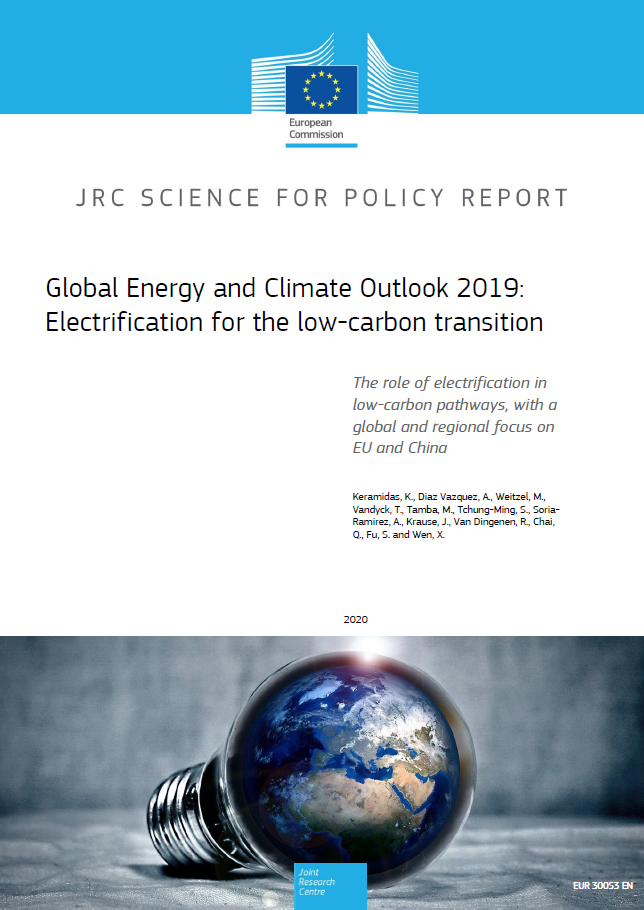The 2019 edition of the Global Energy and Climate Outlook (GECO) focuses on the shift towards clean electricity to limit global warming to below 2°C by the end of the century as put forward in the UNFCCC Paris Agreement. The report is a collaborative effort between the European Commission’s Joint Research Centre (JRC), the Chinese National Center for Climate Change Strategy and International Cooperation (NCSC) and Energy Foundation China (EFC).
This edition further analyses global and sectoral pathways towards a deep decarbonisation of the energy system, highlighting the role of electrification as a key option in the transition to a low-greenhouse gas (GHG) economy. The quantitative analysis combines global energy system and macroeconomic modeling, and tests different assumptions on a number of underlying drivers for electrification across all sectors of the economy: transport, buildings and industry.
Furthermore, this report presents a special insight into the role of electricity in regional GHG emission reduction pathways for the European Union and China.
GECO 2019 - Energy, Greenhouse gas and air pollution emissions balances
A set of 3 projections with an energy-emissions model - using common socio-economic assumptions

Global emission trends
In order to achieve the ambitious transition to a low carbon economy meeting the 2°C target, global greenhouse gas emissions need to drop to net zero in the second half of the century. GECO 2019 analyzes different pathways towards this temperature target that vary in the level of end-use electrification.
Key mitigation options involve expanding the use of renewables and an increasing role of electricity in the energy we consume in addition to improvements in energy efficiency.
- Current policies (Reference scenario) lead to temperature increases between 3-4°C at the end of the century.
- Implementation of Nationally Determined Contributions lead to about 2.8°C; additional policies are needed to increase decarbonisation.
- In a 2°C scenario, global GHG emissions in 2050 are reduced by 68% compared to their 2018 levels, reaching net-zero emissions around 2080 across all 2°C scenarios with different assumptions on electrification drivers (green shaded zone).
- For a global mean temperature increase of 1.5°C, global GHG emissions in 2050 are reduced by 84% from the 2018 levels, reaching net-zero emissions around 2060.
Note: Global GHG emissions and global mean temperature change in the GECO2019 scenarios. In global mean temperature change, lines represent median probability and shaded areas represent 25%–75% probability. The 2°C and 1.5°C scenarios were designed with a probability not to exceed their temperature change at the end of the century of 75% and 66%, respectively.
Mitigation options and electrification
Electrification of final energy demand coupled with the decarbonisation of the production of energy carriers (electricity, hydrogen, synthetic fuels) is essential in the transformation ahead. The report identifies key factors that enable electrification and reveals how their evolution over the next decades impacts the role of electricity in climate change mitigation. Future fossil fuel and biomass prices, battery costs, the cost of heat pumps and many other factors are considered and their effect is quantified in the report.
A transition towards a low-carbon economy making use of electrification would require:
- The decarbonisation of power generation, lowering the carbon intensity of electricity.
- The shifting of energy carriers in thermal and mobility end-uses from mainly fossil fuels towards electricity and derivative fuels (green hydrogen, e-fuels).
- The increase in the energy efficiency of end-uses. Electrification can contribute to that.
- The mobilization of new energy solutions such as demand-side load management, power storage and low-carbon-powered synthetic fuels production.
Notes: Drivers of GHG emissions growth and mitigation options and role of electrification in the 2°C-Medium scenario, 2015–2050, World. "Activity": emissions growth due to the growth of population and the economy, and to associated income-based consumption (industrial value added, transport activity, dwelling size, electricity consumption). "AFOLU": Agriculture, Forestry and Other Land Use. "Biomass - Traditional": refers to the phase-out of traditional biomass for reasons other than climate policies, resulting in an energy demand gap that has to be met by other fuels. "HDD": emissions from buildings' space heating prevented by the evolution over time of heating degree-days due to global warming. "CCS": emissions prevented by carbon capture and sequestration. "Fossil fuels switch": refers to shifts from high-carbon content towards lower-carbon content within the fossil fuel mix (generally from coal to natural gas). "Energy & Industry non-CO2": including emissions reductions from fossil fuel extraction and transport directly related to the decrease in the use of fossil fuels in all energy demand sectors. "Synthetic methane", "Synthetic liquids", "Hydrogen", "Biomass - Modern", "Electricity": emissions prevented by the use of these fuels in final demand sectors (emissions for their production distributed in the other options here). "Biomass – Modern": includes liquid biofuels. "Efficiency": structural efficiency and efficiency in the provision of energy services not attributable to the other technological options detailed here.
Economic implications
The report also looks into the macro-economic implications of climate change mitigation in general, and pays particular attention to the effects of road transport electrification. Findings clearly illustrate that transport electrification is a valuable option in a 2°C world, as globally aggregated GDP would be 1-3% lower in 2050 if the 2°C target would be met without road transport decarbonisation. The transition from conventional vehicles to electric vehicles drives changes in production structure and maintenance requirements. How these changes impact sectoral employment patterns is also quantified in the report. In 2050, over 4 million workers that would have been active in the manufacturing of conventional vehicles globally are employed in other sectors of the economy, such as EV manufacturing and the sectors related to the bio-economy.
GECO 2019 has been produced in close collaboration with DG CLIMA, with comments from DGs ENER and MOVE.
